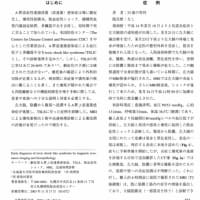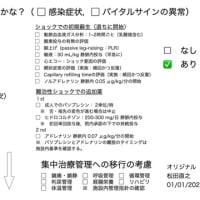世界保健機構による敗血症管理政策の議決
世界の目の「敗血症 SEPSIS」に向けて
2017年5月26日にジュネーブで開催されたWHO(世界保健機構)集会(第3日目)において,WHOはSepsis(敗血症)の転帰を改善することを重要課題として議決しました。ここまでの道のりは長かったですが,「敗血症」が20年をかけて真の病態学的重要性として認知されはじめ,WHOや世界が「敗血症」を当面の解決すべき「病気」として議決したことは学術的な一つの進展です。
2016年2月には,JAMA(米国医師会雑誌)に新しい敗血症の定義「SEPSIS-3」が公表され,敗血症の重症化においては多臓器不全が進行する病態として,診療体制を集中治療領域に集約させる,国際的な提案がなされています。
手術後,心肺停止後,多発外傷,急性心不全,広範囲熱傷,災害医療などの超急性期病態の一系は,敗血症に類似した高サイトカイン血症と交感神経緊張により形成されます。病気学を病態学として,創薬を病気学ではなく病態学に基づいて行うことが,これからは期待されるところです。多くの病気の表現型をより単純に病態学として理解し,投薬や管理をシンプルとしていく時代が来ています。これは,超急性期医学においては,病態学的進化としての「救急・集中治療医学革命」となります。医学は,超急性期(災害拠点病院),急性期,静着期(acute to stable),慢性期などのように緊急性の観点からも分類することができます。
そういう中で,「敗血症」というのは,理学所見などの表現型はさまざまであっても,本態は「マルチサイトカイン血症」です。1996年の昔,「先生は,どうしてそのような海のものとも,山のものともわからぬ研究をしたいんですか?学位など取れませんよ」と言われたことがあります。こういう,例えばあまり注目されてこなかったけれども重要な学術を発展させる一端として,今の臨床では「救急医療」,そして「集中治療」が存在します。「どうして,救急医療や救急医学を育成しようとするんですか?」。要請された以上は,すべての患者さんを内容を限らずに受け入れ,急性期管理医学として,その病態を見極める「診療」と「教育」を発展させる必要があります。ここに,学術と成長が生まれます。学術は,「感性」と「洞察性」と「継続性」により生まれます。支える「仕組み」は作る気持ちさえあれば,直ぐにできます。人を助けることを恐れてはいけないと考えています。そして,自身や場を助けるということは,「肯定」を継続できるように,自身が努力するということです。「努力」は,達成されるまで続けることが大切であり,その道が「自身や環境を育てる」ことにつながります。これが,「勇気ある知識者」です。
世界にとって,大学は,総合的かつ平等的な学力でなければなりません。学術に否定は不要であり,将来を感知するように努力し,今を越えて包容性を保つように努力し,イデオロギーを超えて「偏り」を修正し,しっかりと「均等」に「診療」と「学術」を形成することが「大学」や「個人」に期待されます。

Recognizing Sepsis as a Global Health Priority — A WHO Resolution
“Some very important clinical issues, some of them affecting life and death, stay largely in a backwater which is inhabited by academics and professionals and enthusiasts, dealt with very well at the clinical and scientific level but not visible to the public, political leaders, leaders of healthcare systems. . . . The public and political space is the space in which [sepsis] needs to be in order for things to change.”
So said Sir Liam Donaldson, the former chief medical officer for England and the current World Health Organization (WHO) envoy for patient safety, on May 24, 2017. ref 1) Two days later, the World Health Assembly (WHA), the WHO’s decision-making body, adopted a resolution on improving the prevention, diagnosis, and management of sepsis. ref 2)
The term “sepsis” dates back to at least the time of Hippocrates, who considered it the process by which flesh rots and wounds fester. More recently, it has been defined as life-threatening organ dysfunction resulting from infection. Despite this long history, sepsis has existed in the backwater described by Donaldson, and as a result innumerable patients around the world have died prematurely or faced long-term disability. This toll of unnecessary suffering drove Germany, with the unanimous support of the WHO executive board and at the urging of the Global Sepsis Alliance (GSA), to propose the resolution adopted by the WHA. The resolution urges member states and the WHO director general to take specific actions to reduce the burden of sepsis through improved prevention, diagnosis, and management.
The true burden of disease arising from sepsis remains unknown. The current estimates of 30 million episodes and 6 million deaths per year come from a systematic review that extrapolated from published national or local population estimates to the global population. ref3) The likelihood that the result was a significant underestimate was recognized by the authors, who could find no data from the low- and middle-income countries (LMICs) where 87% of the world’s population lives. Thus, their estimate is based on data on hospital-treated sepsis in high-income countries. This lack of data is compounded by the fact that sepsis is treated as a “garbage code” in the Global Burden of Disease statistics, where most deaths due to sepsis are classified as being caused by the underlying infection. Improving the coding of sepsis and establishing a proper accounting in those statistics are essential steps envisaged by the WHA.
The resolution also calls for health care workers to increase awareness of sepsis by using the term “sepsis” in communication with patients, relatives, and other parties. ref4) National surveys consistently report low community awareness of sepsis, its signs and symptoms, its causes, and its toll of death and disability. In Australia, only 40% of surveyed people had heard of sepsis and only 14% could name one of its signs. In Brazil, the figures are even lower, with 7% of surveyed people aware in 2014 and 14% in 2017. In the United States, the United Kingdom, and Germany, high-profile campaigns have proven effective and increased awareness to 55%, 62%, and 69%, respectively.
Ensuring greater awareness on the part of both the public and health care workers is a crucial step in reducing the global burden of sepsis. Approximately 70% of sepsis cases are community-acquired, and since treatment with appropriate antibiotics must begin early to be effective, educating people about seeking treatment without delay is key to preventing unnecessary deaths and disability. The progression from infection to sepsis can be insidious and is unpredictable. Although populations such as the very young, the very old, and the immunosuppressed are known to be at high risk and should be targeted for education, sepsis can affect anyone at any time, which means that national public awareness programs are needed.
Awareness programs should also teach health care workers both to recognize sepsis and to understand it as a true time-critical medical emergency. Government reports and individual patient stories consistently identify delayed treatment as a major cause of preventable death and disability. ref 5) Encouraging patients, relatives, and health care workers to ask “Could this be sepsis?” saves lives.
Clear treatment guidelines and performance targets tailored to local environments and available resources are also essential. Effective examples of this approach that have reduced mortality can serve as templates to be adapted for local conditions and use; these include “Rory’s Regulations” in New York State, the “Sepsis Kills” program in New South Wales, Australia, the National Health Services’ commissioning levers in England, and a multifaceted education program in Brazil.
Promulgation of comprehensive treatment guidelines such as those developed by the Surviving Sepsis Campaign has been associated with reduced mortality in high-income countries, but guidelines written for and by clinicians in these countries may not be applicable in the LMICs that bear most of the sepsis burden. Context-specific guidelines or modification of current guidelines for individual LMICs will be most effective if the guideline process is led by local clinicians and policymakers; the resolution envisages the WHO, in collaboration with others, playing a role in the development and promulgation of such guidelines. In addition, attention to bolstering public health initiatives to prevent sepsis, surveillance systems for detecting outbreaks early, and provision of simple early treatment can help to counterbalance the effects of a lack of critical care facilities in many LMICs.
The WHO resolution recognizes the perceived conflict between rapid administration of antibiotics to treat sepsis and efforts to combat antimicrobial resistance. Global efforts to reduce the burden of sepsis must go hand in hand with measures to minimize antimicrobial resistance and be consistent with the WHO-approved Global Action Plan on Antimicrobial Resistance. However, sepsis is the condition that is most appropriate to treat empirically with broad-spectrum antibiotics, with rapid deescalation based on identification of the causative organisms.
Progress toward the GSA’s vision of “a world free of sepsis” also requires recognition of the key role of prevention. Prevention of infection and resultant sepsis through vaccination; access to clean water, sanitation, and hygiene (WASH) in homes, schools, and health care facilities; clean childbirth and surgical practices; and hand hygiene in health care facilities is already the focus of WHO programs. The new resolution on sepsis supports and reinforces these programs.
Increased awareness, early presentation to a health care facility or early recognition of health care–associated sepsis, rapid administration of appropriate antibiotics, and urgent treatment according to locally developed guidelines can significantly reduce deaths from sepsis. Since such measures have reduced case fatality rates in high-income countries, however, the substantial burden carried by survivors of sepsis has become clearer. The sequelae of sepsis can include clinically significant physical, cognitive, and psychological disability that often goes unrecognized and untreated. In LMICs, postdischarge mortality after sepsis is about the same as sepsis-related mortality in the hospital, and perinatal sepsis poses great and ongoing risks for both mother and infant. Yet around the world, coordinated services for sepsis survivors are virtually nonexistent.
The WHA resolution, with its implicit recognition of sepsis as a major threat to patient safety and global health, has the potential to save millions of lives. To realize this potential, the actions proposed in the resolution need to be taken. These actions require coordinated efforts by politicians, policymakers, health care administrators, researchers, and clinicians working with people of all ages in all health care settings and in the community. Actions will vary by region and country and must acknowledge the unique challenges faced by LMICs.
REFERENCES
1. “WHA Side Event on Sepsis” in Geneva. YouTube. May 24, 2017 (https://www.youtube.com/watch?v=k-dEPnBzuMc&feature=youtu.be).
2. WHA adopts resolution on sepsis. Jena, Germany: Global Sepsis Alliance, May 26,2017 (https://www.global-sepsis-alliance.org/news/2017/5/26/wha-adopts-resolution-on-sepsis).
3. Fleischmann C, Scherag A, Adhikari NKJ, et al. Assessment of global incidence and mortality of hospital-treated sepsis: current estimates and limitations. Am J Respir Crit Care Med 2016;193:259-272
4. Just say sepsis! A review of the process of care received by patients with sepsis. London: National Confidential Enquiry into Patient Outcome and Death, November 2015 (http://www.ncepod.org.uk/2015report2/downloads/JustSaySepsis_FullReport.pdf).
5. Time to act: severe sepsis — rapid diagnosis and treatment saves lives. London: Parliamentary and Health Service Ombudsman, 2013 (https://www.ombudsman.org.uk/publications/time-act-severe-sepsis-rapid-diagnosis-and-treatment-saves-lives-0).
※ 本内容は,2017年7月1日に一般公開し,同日,一部の修正としています。 松田直之
※ 本内容は,2017年7月5日,2017年7月20日,2017年7月28日,2017年10月25日に一部に追記や修正をしています。 松田直之



























